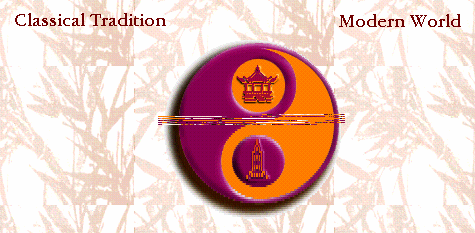

These are probably the most common techniques of TCM known to the western side of the planet. Some less known techniques are Cupping: the placement of glass, plastic or bamboo cups on the skin with a vacuum created with heat; Moxa: the burning of an herb called mugwort, on or near an accupuncture point; Plum blossum or seven star: the light tapping of an area of the body with a sterile hammer which has seven points and Gua Sha: rubbing the surface of the skin with a ceramic spoon or coin.
For additioanl information regarding acupuncture link to this brief introduction and to Heidi Mo Hawkin's Acupuncture World
Acupuncture is fairly known to the west. Many states in the United States recognize it as part of the health care system, and have professional institutions where acupuncturists receive their education and training. One such institution is Bastyr University in the state of Washington and the Emperor's College of Traditional Oriental Medicine located in Santa Monica, California.
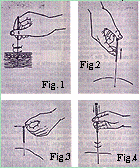 Acupuncture is an important branch of TCM used in prevention and treatment of diseases. It is a form of natural therapy which regulates the functioning of the viscera, meridians, qi and blood by needling and moxa burning and various other methods of stimulating acupoints. There are several methods to use the needles. Rotating method (Fig.1).The needle is rotated clockwise and counterclockwise after its insertion. When the angle of rotation is larger and the frequency higher higher, the stimulation will be stronger. Handle-scraping method (Fig.2). The needle is fixed on the proper acupoint by placing the thumb of the right hand lightly on its end, then scrape the handle of the needle with the nail of the index finger upward and downward to stregthen the stimulation of the needle. Flicking method (Fig.3). The inserted needle is flicked by its handle witha finger to elicit a light vibration so as to induce the needling reaction. Vibrating method (Fig.4). The needle is held with the thumb, index and middle finger. It is then lifted-thrusted and rotated swiftly in a small amplitude to elicit a vibration.
Acupuncture is an important branch of TCM used in prevention and treatment of diseases. It is a form of natural therapy which regulates the functioning of the viscera, meridians, qi and blood by needling and moxa burning and various other methods of stimulating acupoints. There are several methods to use the needles. Rotating method (Fig.1).The needle is rotated clockwise and counterclockwise after its insertion. When the angle of rotation is larger and the frequency higher higher, the stimulation will be stronger. Handle-scraping method (Fig.2). The needle is fixed on the proper acupoint by placing the thumb of the right hand lightly on its end, then scrape the handle of the needle with the nail of the index finger upward and downward to stregthen the stimulation of the needle. Flicking method (Fig.3). The inserted needle is flicked by its handle witha finger to elicit a light vibration so as to induce the needling reaction. Vibrating method (Fig.4). The needle is held with the thumb, index and middle finger. It is then lifted-thrusted and rotated swiftly in a small amplitude to elicit a vibration.
A modern method of acupuncture is electrostimulation. It uses low eletrical currents provided by a specially designed stimulator as the one shown below. The needles are connected to the stimulator by the proper clips.
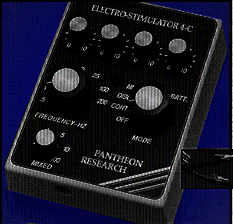
What many scientists in the west would like to know is not only if acupuncture works, but how it works . Charles Shang has compiled a useful set of information regarding The Mechanism of Acupuncture . He gives an explanation of acupuncture using western medical and scientific terminology. In addition, this report gives an extensive list of references about the subject. Some additional comments are expressed in this report titled The East and West about Acupuncture .
A vital aspect of acupuncture is the location of Clinical Points . This Theory is a good introduction to the Point Selection Theory.
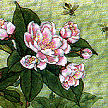 Herbal Medicine is another integral part of the Traditional Chinese Medicine; it is widely used in conjunction with acupuncture. After a visit to the acupuncturist or to the doctor of oriental medicine, the patient will must likely recieve a prescription of herbal medicine. Unlike its western counterpart, herbal prescription is not purchased from a pharmacist; the doctor will give the herbs to the patient and he/she will prepare them at home following the instructions given by the doctor.
Herbal Medicine is another integral part of the Traditional Chinese Medicine; it is widely used in conjunction with acupuncture. After a visit to the acupuncturist or to the doctor of oriental medicine, the patient will must likely recieve a prescription of herbal medicine. Unlike its western counterpart, herbal prescription is not purchased from a pharmacist; the doctor will give the herbs to the patient and he/she will prepare them at home following the instructions given by the doctor.
There are hundreds of herbs used in Traditional Chinese Medicine. They are not usually taken one at the time, but a mixture of them. Oriental and western scientists have done research in the therapeutic effects of herbal medicine; for a comprehensive view of this topic see this review about Herbology
These are the pictures of some herbs with medicinal uses:
 |
 |
 |
|---|---|---|
 |
 |
 |
These are additional pictures of Chinese herbs . Double click the name of the picture you want to see.
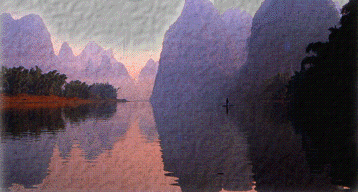 Qi Gong is a Chinese system of physical training, preventive and therapeutic health care. It combines aerobic conditioning, isometrics, isotonics and relaxation. Medical Qi Gong involves breathing exericises combined with relaxation and meditation. In the Qi Gong state, troubles are washed away and replaced by positive images and increased confidence.This is an Introduction to Qi Gong which explains the medical benefits of practicing Qi Gong. The practice of Qi Gong has awaken the curiosoty of some scientists; they have made studies using western scientific techniques. For More about Qi Gong click here; and this is an interesting Review about Qi Gong written by a student form San Francisco State.
Qi Gong is a Chinese system of physical training, preventive and therapeutic health care. It combines aerobic conditioning, isometrics, isotonics and relaxation. Medical Qi Gong involves breathing exericises combined with relaxation and meditation. In the Qi Gong state, troubles are washed away and replaced by positive images and increased confidence.This is an Introduction to Qi Gong which explains the medical benefits of practicing Qi Gong. The practice of Qi Gong has awaken the curiosoty of some scientists; they have made studies using western scientific techniques. For More about Qi Gong click here; and this is an interesting Review about Qi Gong written by a student form San Francisco State.
 Chinese nutrition also plays an important role within Traditional Chinese Medicine. Grains, fruits and vegetables are the core of oriental nutrition with fish and poultry as complementary
dishes. Traditional Chinese Medicine emphasizes little meat and lots of vegetables. Clark Casteel has prepared a report that explains the benefits and disadvantages of Vegetarianism .
Chinese nutrition also plays an important role within Traditional Chinese Medicine. Grains, fruits and vegetables are the core of oriental nutrition with fish and poultry as complementary
dishes. Traditional Chinese Medicine emphasizes little meat and lots of vegetables. Clark Casteel has prepared a report that explains the benefits and disadvantages of Vegetarianism .
Traditional Chinese Medicine employs the benefits of a healthy diet as preventive therapy and, in some cases, as part of a certain therapy. Actions of Food describes the preventive and curative aspects of several types of food emphasized on Traditional Chinese Medicine.
In recent years, the National Institute of Health (NIH) has opened its doors to research about Traditional Chinese Medicine.The NIH created the Office of Alternative Medicine (OAM) with the purpose to study the different aspects of this topic. Some grants have been awarded to the study of Alternative Medicine and its research has expanded recently. The NIH has prepared a document called Exploratory Grants for Alternative Medicine for those scientists interested in the subjcet. The NIH also uses the name of Holistic Medicine when talking about Traditional Chinese Medicine and its ramifications.
The National Cancer Institute has also acknowleged some of the benefits of alternative medicine in the west. It cautiously recommends the use of alternative medicine in conjuction with western medicine to treat some of the symptoms of certain illnesses. Some of the recommendations from the NIH are found in this document about Holistic Medicine .
Other western countries have also expanded their research of Traditional Chinese Medicine.One member of the Royal London Homeopathic Hospital Trust has published a document about Modern Acupuncture .
 Traditional Chinese Medicine is an exciting field to study and discover. As the National Cancer Institute recommends, we should approach this subject with caution and enjoy the benefits that it has to offer. For further information and books, see the California State University, Los Angeles library (login as library). Scientific research in recent years has produced a vast source of information about Traditional Chinese Medicine, especially acupuncture. See this list of references from western journals about Traditional chinese Medicine. Melvyl and CARL are also available to get more information from books and journals.
Traditional Chinese Medicine is an exciting field to study and discover. As the National Cancer Institute recommends, we should approach this subject with caution and enjoy the benefits that it has to offer. For further information and books, see the California State University, Los Angeles library (login as library). Scientific research in recent years has produced a vast source of information about Traditional Chinese Medicine, especially acupuncture. See this list of references from western journals about Traditional chinese Medicine. Melvyl and CARL are also available to get more information from books and journals.
The following has been added by the Electronic Desktop Project:
 Contact Us
Contact UsIf you are an educator who is using our NEXTSTEP or virtual applications in the classroom, we would especially like to hear from you. Let us know what you are doing and how it is working out. Continued support for this project will depend on its impact in science education.
If you are an educator who is interested in making use of our NEXTSTEP or virtual applications, please let us know how we can help.
 Return to the Electronic Desktop Project home page
Return to the Electronic Desktop Project home page
![]() Check out the WWW Virtual Application Catalog from the EDP
Check out the WWW Virtual Application Catalog from the EDP
 Check out the NEXTSTEP Application Catalog from the EDP
Check out the NEXTSTEP Application Catalog from the EDP
 Visit the home page for California State University, Los Angeles
Visit the home page for California State University, Los Angeles